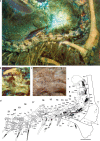Ultraviolet light illuminates the avian nature of the Berlin Archaeopteryx skeleton
- PMID: 31019224
- PMCID: PMC6482141
- DOI: 10.1038/s41598-019-42823-5
Ultraviolet light illuminates the avian nature of the Berlin Archaeopteryx skeleton
Abstract
The question of whether the iconic avialan Archaeopteryx was capable of active flapping flight or only passive gliding is still unresolved. This study contributes to this debate by reporting on two key aspects of this fossil that are visible under ultraviolet (UV) light. In contrast to previous studies, we show that most of the vertebral column of the Berlin Archaeopteryx possesses intraosseous pneumaticity, and that pneumatic structures also extend beyond the anterior thoracic vertebrae in other specimens of Archaeopteryx. With a minimum Pneumaticity Index (PI) of 0.39, Archaeopteryx had a much more lightweight skeleton than has been previously reported, comprising an air sac-driven respiratory system with the potential for a bird-like, high-performance metabolism. The neural spines of the 16th to 22nd presacral vertebrae in the Berlin Archaeopteryx are bridged by interspinal ossifications, and form a rigid notarium-like structure similar to the condition seen in modern birds. This reinforced vertebral column, combined with the extensive development of air sacs, suggests that Archaeopteryx was capable of flapping its wings for cursorial and/or aerial locomotion.
Conflict of interest statement
The authors declare no competing interests.
Figures





Similar articles
-
Axial and appendicular pneumaticity in Archaeopteryx.Proc Biol Sci. 2000 Dec 22;267(1461):2501-5. doi: 10.1098/rspb.2000.1311. Proc Biol Sci. 2000. PMID: 11197125 Free PMC article.
-
Wing bone geometry reveals active flight in Archaeopteryx.Nat Commun. 2018 Mar 13;9(1):923. doi: 10.1038/s41467-018-03296-8. Nat Commun. 2018. PMID: 29535376 Free PMC article.
-
Was dinosaurian physiology inherited by birds? Reconciling slow growth in archaeopteryx.PLoS One. 2009 Oct 9;4(10):e7390. doi: 10.1371/journal.pone.0007390. PLoS One. 2009. PMID: 19816582 Free PMC article.
-
Air-filled postcranial bones in theropod dinosaurs: physiological implications and the 'reptile'-bird transition.Biol Rev Camb Philos Soc. 2012 Feb;87(1):168-93. doi: 10.1111/j.1469-185X.2011.00190.x. Epub 2011 Jul 7. Biol Rev Camb Philos Soc. 2012. PMID: 21733078 Review.
-
New Perspectives on the Ontogeny and Evolution of Avian Locomotion.Integr Comp Biol. 2016 Sep;56(3):428-41. doi: 10.1093/icb/icw065. Epub 2016 Jul 1. Integr Comp Biol. 2016. PMID: 27371381 Review.
Cited by
-
Whence the birds: 200 years of dinosaurs, avian antecedents.Biol Lett. 2025 Jan;21(1):20240500. doi: 10.1098/rsbl.2024.0500. Epub 2025 Jan 22. Biol Lett. 2025. PMID: 39837495 Free PMC article. Review.
-
Histology and pneumaticity of Aoniraptor libertatem (Dinosauria, Theropoda), an enigmatic mid-sized megaraptoran from Patagonia.J Anat. 2020 Oct;237(4):741-756. doi: 10.1111/joa.13225. Epub 2020 May 29. J Anat. 2020. PMID: 32470191 Free PMC article.
-
Common developmental origins of beak shapes and evolution in theropods.iScience. 2025 Mar 19;28(4):112246. doi: 10.1016/j.isci.2025.112246. eCollection 2025 Apr 18. iScience. 2025. PMID: 40235591 Free PMC article.
References
-
- O’Connor MP. The postcranial axial skeleton of Majungasaurus crenatissimus (Theropoda: Abelisauridae) from the Late Cretaceous of Madagascar. Soc. Vertebr. Paleontol. Mem. 2007;8(27):127.
-
- Duncker H-R. The lung air sac system of birds. Adv. Anat. Embryol. Cel. 1971;45:1. - PubMed
-
- Perry SF. Method for reconstructing the respiratory system of extinct animals. Sauropod dinosaurs as a case in point. Comp. Biochem. Physiol. A. 2006;143:61.
Publication types
MeSH terms
LinkOut - more resources
Full Text Sources
Research Materials
Miscellaneous

